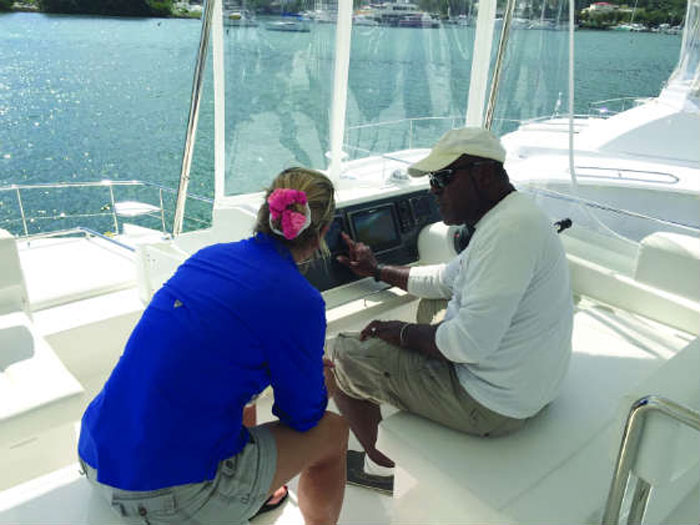How To Get the Most Out of Your Charter Briefing
Few things are more important at the start of a sailing charter than the technical briefing. The base personnel know their boats well (the good and the bad), so find the most competent guy or gal on the dock and don’t let them off the deck until you’re certain you know everything about the boat you’ll be spending a week on.

Test the electronics and the radio.
Today, chartplotters and instruments are standard but not all the same, so go through the basic pages and make sure the information is in English and in units of measure you’re comfortable with. Learn how to make changes if needed. Ask about any offset in the depth reading so you know whether the instruments calculate from the waterline or from below the keel.
Learn the onboard VHF. Don’t just turn it on. Make a call to another boat nearby, and have them call you back. Bring along your handheld VHF from home as backup.
Get personal with the engine.
Charter boat engines do a lot of work because they’re used for both propulsion and battery charging. They’re usually in good shape, but know where your tool kit is and that you have extra engine oil. Have the manager open up the engine compartment and check the bilge, the oil level, and the coolant before you leave. On a catamaran, do this with both engines.
Evaluate the electrical system.
Electrical systems are the number one problem on charter boats. The batteries are often abused and because they’re expensive, charter companies use them well past their prime. Know where the batteries are and how many amp hours you have to work with. Ask how to connect the batteries together in case you need more juice to get the engine started. Understand and test your battery monitor; ask if there is an inverter or generator and turn non-critical items off at night or when you leave the boat.
Ask about fuel and water tanks.
Know the size of your fuel and water tanks and know how many of each you have. If there is a tank monitor, ask if it works. Know where the water fill is and if you have a key for the fitting. Locate a spare water hose onboard, and visually inspect the manifold you’ll need to switch from an empty tank to a full one.
Test the galley basics.
Ask the checkout manager to show you the steps of starting the stove, and see if there is a breaker on the panel as well as a solenoid switch. Lift your propane tank to see how full it is, and make sure you have tools to switch propane bottles if there is more than one. If there is a foot pump at the sink, see if it’s fresh or saltwater. Ask if the fridge is engine driven and how it’s turned on/off. If you plan to barbecue, lay eyes on the grill to determine if it’s charcoal or propane.
Go through the steps of reefing.
Know how to reef before you leave. Is it simple slab reefing or an in-mast furling system? Check whether the lines are at the mast or led aft to the cockpit. If they’re not labeled, pull on each to understand what it controls. In the process, see if the previous charter left a reef in the sail so you don’t get a surprise. Knowing how to reef quickly is a safety essential, especially in areas of heavy winds.
Don’t forget about the dinghy and outboard.
Inspect the dinghy, and know where your foot pump and paddles are. If the dinghy is on davits, as on most catamarans, understand how to raise, lower, and secure it under way. Ask if there is a lock and key for the outboard and another for the dinghy. If at all possible, start the outboard, and ask about extra fuel.
Learn about any additional and non-standard equipment aboard.
Occasionally, you’ll have extra goodies aboard: a generator, electric winches, watermaker, electric heads, or daggerboards on a catamaran. Don’t let your checkout manager leave without walking you through the intricacies of each system including how to turn it on/off, how to troubleshoot minor problems, and whether the equipment actually functions.
Bring a friend and some technology to the checkout.
Much information is passed on during a checkout, and most of it will be new and specific to your boat. It’s hard to remember everything, so bring along one of your crew to walk through systems with you and take notes while you ask questions and pay attention. That way, when it’s time to find the tank manifold, you’ll have two memory banks to rely on.
Bring a smartphone or tablet to take pictures or even record or video the briefing. For that matter, bring those to your chart briefing as well, so that when the manager tells you of that super secret anchorage that’s not to be missed, you’ll be able to find it later.
By Zuzana Prochazka




